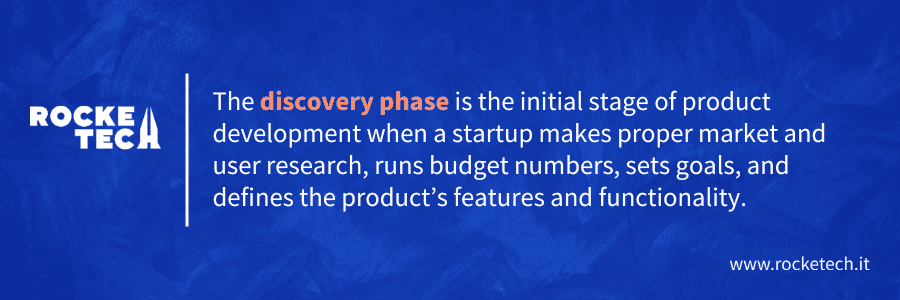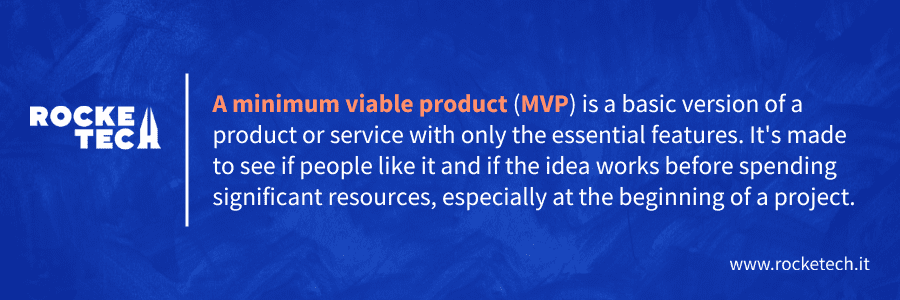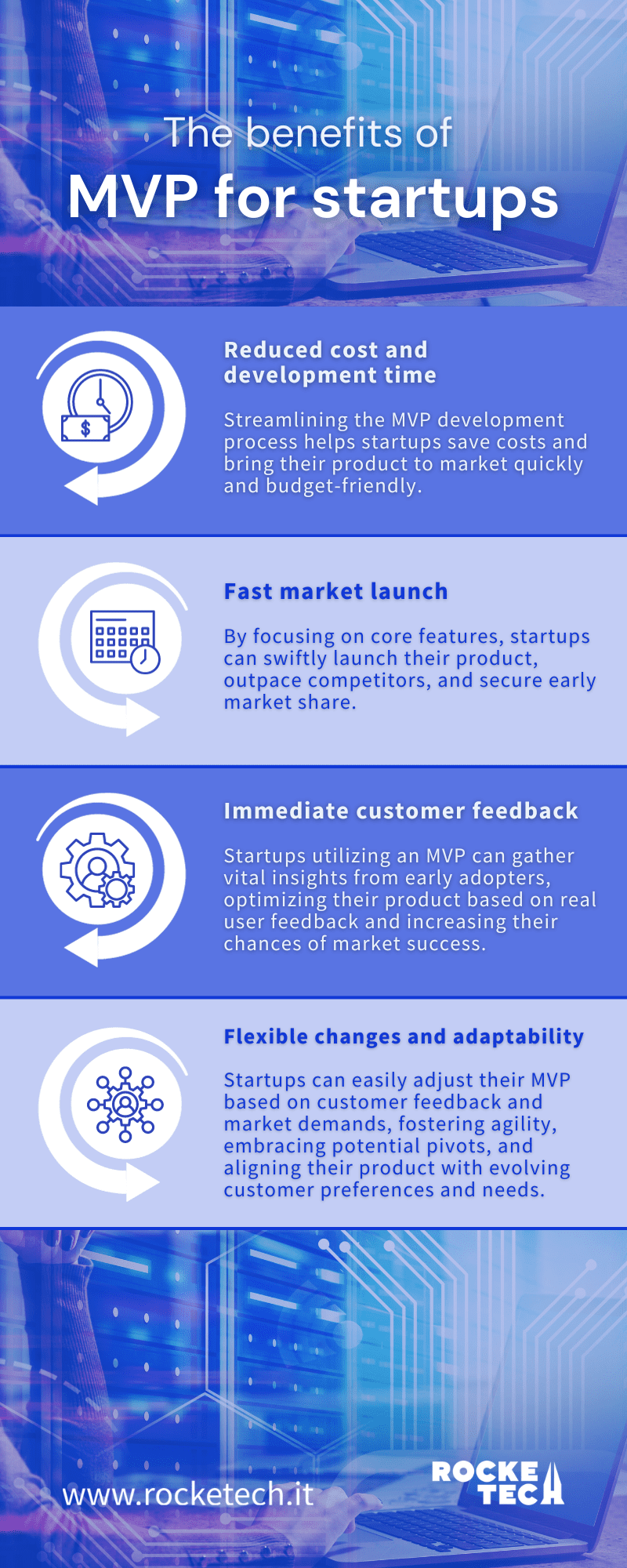Typically, just one in ten mobile app development projects turns out profitable. While the usage of smartphones is on the rise, the number of mobile products is also increasing. At the same time, the average session time is decreasing, and user attention is becoming progressively more valuable with each passing year. In these highly competitive environments, custom mobile app development for startups turns from a luxury option into a business requirement.

Do you have a startup product idea but don’t know what to begin with? Our guide on app development for startups will help you get your ducks in a row.
Why Does a Startup Need a Mobile App?
Essentially, startups are projects with low budgets and high risks. That’s why mobile app development for startups is an instrument they use to test business hypotheses and, ideally, find investors for further rapid expansion. Here are seven reasons why your startup does need a mobile solution.
- Quick Market Presentation
With a well-designed app, they can showcase their products or services, highlight their unique selling points, and create a lasting impression on potential customers.
- Convenient Sales Channel
Mobile apps provide a convenient method for startups to sell their products or services directly to their target audience. By offering a seamless and user-friendly purchasing experience, startups can maximize their reach and increase their sales potential.
- Constant Customer Engagement
Mobile apps enable startups to establish and maintain constant communication with their customers. Through push notifications, personalized offers, and in-app messaging, startups can keep their customers engaged, informed, and loyal to their brand.
- Direct Feedback
Mobile apps allow startups to gather direct feedback from their customers. This valuable feedback helps them understand customer preferences, identify areas for improvement, and make informed business decisions.
- Simplicity and Accessibility
Compared to a website, mobile apps offer a simpler and more accessible user experience. With a few taps on their smartphones, users can access the app and find what they need quickly.
- Streamlined Business Processes
Developing a mobile app enables startups to automate internal business processes like inventory management, order processing, or customer support. This automation saves time and resources.
- Data Collection and Analysis
By collecting user behavior, preferences, and demographics, startups can gain insights into customer trends and make data-driven decisions to enhance their products or services.
Why Your App Won’t Pay Off
While app development for a startup no longer seems extraordinary, there are many ways to do it wrong and fail. We summed up the five most common reasons why it happens.
#1 The problem you’re solving doesn’t exist or has already been solved.
Co-founder of Y Combinator, Paul Graham, once said that the most common mistake startups make is solving problems that don’t exist. While we have seemingly the best ideas in our imagination, in reality, potential customers mostly simply don’t need them.
#2 The hypothesis hasn’t been tested.
It’s difficult to speculate about risks without initial customers and figures to base developmental models on. Testing the hypothesis allows for ample maneuvering room for ideas in the early stages when their cost is close to zero.
#3 You’ve planned too many features.
Building a full-fledged starship ready for a Mars mission right from the start is not the best strategy. However, some entrepreneurs think adding more features to a product will make it more appealing to customers. It’s not true.
#4 You didn’t define your goals.
It’s crucial to forecast the outcomes the development and growth of an IT product will bring. What indicators need to be achieved within six months to justify the investment risk? What about a year?
#5 Your monetization method is overly aggressive.
Attention from users is the primary asset in the digital world. Even in a financially unprofitable project, having a large community is a success. Attracting attention is harder than converting it into profitability. Aggressive monetization at the early stages of a service’s life cycle often leads to an inability to gather a sufficient user base.
App Development for Startups: The 2-Phase Approach
In general, the development process can be broken down into understandable phases that make up a plan. Approaches to process-building may differ from vendor to vendor. At Rocketech, we believe that startups require a slightly different and almost always tailored approach. For simplicity, let’s divide the entire development process into three large steps.
1. Start with a Discovery
Effective planning is half the battle. If you only have what you believe to be a genius idea and a half-written business plan, you are likely to fail. To prevent this scenario, meticulous planning is necessary. We have found that conducting a project discovery is the best way to set sail.

In simple words, it’s an essential phase for startups as it helps them understand what their customers want, which is the key to achieving success in the market. In short, a discovery phase has three main advantages.
- It saves time and money.
The main goal is to create the most in-depth and budgeted startup development plan possible. The more detailed your plan is, the fewer problems you’ll have on the way. Scrupulous planning also helps you avoid redundant functionality and see where you can save time and, as a result, money.
- It defines the product.
It’s impossible to make a good plan if you don’t understand what exactly needs to be done. Another big objective of this stage is to define the product’s features and functionality. And it requires proper market research — it also prepares you for the real-market environment.
- It reduces risks.
The discovery phase helps identify potential risks and challenges early in the project, allowing startups to mitigate them before they become bigger problems. In other words, developers with experience in similar projects will consider the risks and issues (and the ways to solve them) even before they happen.
Like any other project, the discovery phase includes several steps. If done right (and systematically), this stage’s outcome will be a solid roadmap and a clear picture of the near future, minimizing the uncertainty.
#1 Do Your Market Research
First things first: before you make any plans and, even more so, start developing your app, it’s vital to explore the environment and define the real market situation. Here are the questions covered by proper market research:
- What products exist in the chosen niche and make up your competition?
- Why do some products succeed while others fail?
- What strong sides and weaknesses do your competitors have?
- Which unique features can your product offer that your competitors don’t have (yet)?
#2 Make Accurate Estimations
A precise budget prediction is the unicorn of the custom software development world. In very few cases, everything goes as planned. However, the best app developers for startups are distinguished by experience — they’ve already solved whatever problem may await your project on the way.
In short, here are the seven most common agile project estimation challenges:
- Uncertainty
- Incomplete requirements
- Complexity
- Limited resources
- Time constraints
- Scope creep
- External factors
While these problems are familiar even to non-dev people, there are also specific estimation mistakes only experienced developers can help you avoid. Here’s where expert risk assessment comes into play.
Such probability analysis is essential for making accurate estimates and building a repository of potential future risks. By analyzing past project issues, software development providers create a list of possible problems that can occur. When starting new projects, they refer to this list to identify relevant risks.
#3 Make a Hypothesis
Startups make business hypotheses by formulating educated guesses about market dynamics and their business model’s various aspects. These hypotheses serve as the foundation for their strategy and decision-making process. Here’s a general framework for how startups develop business hypotheses.
- Identify the problem.
Start with identifying a problem or pain point in the market. Conduct research, gather data, and analyze trends to understand the needs and challenges of potential customers. The results will form the basis of your problem hypothesis.
- Propose a solution.
Once the problem is identified, propose a solution or product that addresses the issue. Outline key features, benefits, and value propositions of your crafted solution. The results will form the basis of your solution hypothesis.
- Target the market and segment customers.
Define your target market and segment it into specific customer groups based on demographics, psychographics, or other relevant characteristics. Develop hypotheses about the customer segments most likely to adopt your solution and provide the highest growth potential.
- Make your value proposition.
Articulate the unique value you offer to customers compared to existing alternatives. Formulate hypotheses about your solution’s specific aspects that will resonate with customers and differentiate your offer from competitors.
- Define the revenue model.
Explore existing ways to generate profit — subscriptions, advertising, licensing, or transaction fees. Test assumptions about pricing, customer willingness to pay, and overall revenue potential.
- Specify customer acquisition and distribution channels.
Consider different marketing channels — digital advertising, social media, content marketing, partnerships, or direct sales. Analyze the cost of customer acquisition and experiment with different channels to validate your hypotheses.
- Test and validate.
Naturally, hypotheses are created to be validated. Once you have them ready, start designing experiments and conducting tests. At the very beginning, startups use problem and solution interviews and surveys to gather the data necessary to come up with development requirements. Eventually, the best and fastest way to confirm or refine your idea is to launch an MVP.
2. Build an MVP to Validate Your Idea
Essentially, there are two main ways to make and launch a mobile app. You can spend a long time and all your resources working on a single business idea and polishing numerous features to perfection. While it sounds good to some business owners, the outcome of such projects is unknown at best. In many cases, that perfection turns out not needed by real users.
The alternative way app developers for startups mostly take — you can launch the first, limited yet fully functional product version and refine and improve it according to your customer feedback and real-market environment.

Imagine a unique-to-market product idea for an app that will revolutionize pet ownership. Complex ambitious solutions like this combine features and functionality of various types — a marketplace, social network, and interactive map, in this case.
Instead of gambling on hypothetical ideas, decision-makers launched an MVP with simple functionality four months after the project had started. This approach helped them build a highly interactive, full-fledged mobile application with great market potential within just eight months, well ahead of the competition.

Startup MVP development is a strategic instrument (and a particular mindset, for that matter) to stay afloat in highly competitive markets where every day can be game-changing. After launching the first stable and functional version, you can then focus on your customers and their needs. And develop and improve your offer accordingly.
In other words, let your MVP “run free” and bring the data that will tell you where to head next.
Launch with Rocketech: Development Starts with the Release
When you decide to find an app developer for your startup, most tech vendors will tell you that you need to start with multiple customer interviews, extensive target audience analysis, and competitor investigation. While they are not wrong, and all these steps are vital for a proper project discovery phase, there’s more to it.
Contrary to popular opinion, we’ve learned that development starts upon the release. You can test your hypothesis with a lot of theoretical moves. But you’ll only really validate your business idea once your product is delivered to its intended users.
to market in the shortest possible time.
Talk to our specialist.